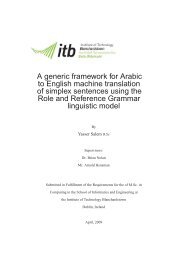On the occurrence and consequences of inaccurate ... - Acsu Buffalo
On the occurrence and consequences of inaccurate ... - Acsu Buffalo
On the occurrence and consequences of inaccurate ... - Acsu Buffalo
Create successful ePaper yourself
Turn your PDF publications into a flip-book with our unique Google optimized e-Paper software.
E.R. Odders-White / Journal <strong>of</strong> Financial Markets 3 (2000) 259}286 273<br />
The 5 second adjustment changes <strong>the</strong> Lee <strong>and</strong> Ready classi"cation (relative to<br />
no adjustment) for only 1218 <strong>of</strong> those trades, however. Although 42% <strong>of</strong> <strong>the</strong><br />
1218 trades are misclassi"ed, eliminating <strong>the</strong> 5 second rule induces more misclassi"cation<br />
than it corrects. Fur<strong>the</strong>rmore, <strong>the</strong> possibility that a 10 second rule<br />
is more appropriate for small stocks (deciles 6}10) was investigated, but <strong>the</strong><br />
5 <strong>and</strong> 10 second rule classi"cations di!ered for only 42 (0.01%) <strong>of</strong> <strong>the</strong> transactions<br />
in <strong>the</strong> sample.<br />
The more frequent misclassi"cation during active trading is not due to<br />
a higher probability <strong>of</strong> occurring inside <strong>the</strong> spread, ei<strong>the</strong>r. In fact, <strong>the</strong> probability<br />
<strong>of</strong> execution inside <strong>the</strong> spread is inversely related to both measures <strong>of</strong> trading<br />
frequency. For example, 15.76% <strong>of</strong> transactions occurring less than 5 s apart<br />
took place inside <strong>the</strong> spread, versus 20.30% <strong>of</strong> those more than 30 s apart.<br />
Similarly, for stocks with 3000 or fewer transactions, 20.5% occurred inside <strong>the</strong><br />
spread, as opposed to 16.73% for stocks with over 15,000 transactions.<br />
If <strong>the</strong> constant changing <strong>of</strong> quotes when trading is frequent is <strong>the</strong> source <strong>of</strong> <strong>the</strong><br />
problem, <strong>the</strong>n a direct relationship should exist between trading frequency <strong>and</strong><br />
quote &freshness' (how recently <strong>the</strong> quotes were updated), <strong>and</strong> also between<br />
quote freshness <strong>and</strong> misclassi"cation. Quote freshness is, in fact, signi"cantly<br />
positively associated with both measures <strong>of</strong> trading frequency. For example, for<br />
stocks with over 3000 transactions, only 29% <strong>of</strong> <strong>the</strong> trades take place more than<br />
5 min after a quote revision, as opposed to over 68% for stock with 3000 or<br />
fewer transactions. Similarly, only 26.55% <strong>of</strong> transactions occurring within 30 s<br />
<strong>of</strong> <strong>the</strong> previous trade take place more than 5 min after a quote revision versus<br />
45.56% when trades are over 30 s apart. In addition, Table 4 Panel D shows that<br />
<strong>the</strong> recent updating <strong>of</strong> quotes is associated with increased misclassi"cation as<br />
well. In particular, 17.48% <strong>of</strong> transactions occurring 1 min or less after a quote<br />
change are misclassi"ed versus only 13.01% <strong>of</strong> transactions with lag times over<br />
5 min. The relation is also monotonic within <strong>the</strong> "rst category, with transactions<br />
taking place within 10 s <strong>of</strong> a quote change signi"cantly more likely to be<br />
misclassi"ed than <strong>the</strong> o<strong>the</strong>rs. The relation between quote freshness <strong>and</strong> frequent<br />
trading does not completely drive <strong>the</strong> increased misclassi"cation associated with<br />
frequent trading, however (results not shown).<br />
Firm size also plays a role in misclassi"cation (Table 4 Panel E), with large<br />
stocks misclassi"ed much more frequently than small stocks (16.08% vs. 6.83%).<br />
Particularly striking is <strong>the</strong> fact that almost 95% <strong>of</strong> <strong>the</strong> transactions misclassi"ed<br />
by <strong>the</strong> Lee <strong>and</strong> Ready method occur in stocks from <strong>the</strong> largest "ve deciles<br />
(45,409 <strong>of</strong> <strong>the</strong> 47,863 total). This is due only in part to <strong>the</strong> greater number <strong>of</strong><br />
transactions for <strong>the</strong>se stocks.<br />
The increased misclassi"cation <strong>of</strong> large stocks cannot be entirely explained by<br />
ei<strong>the</strong>r a higher probability <strong>of</strong> occurring inside <strong>the</strong> spread or by <strong>the</strong> positive<br />
correlation between "rm size <strong>and</strong> trading frequency (or by both). Although<br />
transactions in large stocks are more likely to take place inside <strong>the</strong> spread than<br />
small stocks (19.72 vs. 12.57% with a p-value <strong>of</strong> 0.001), <strong>the</strong> results in Panel E
















